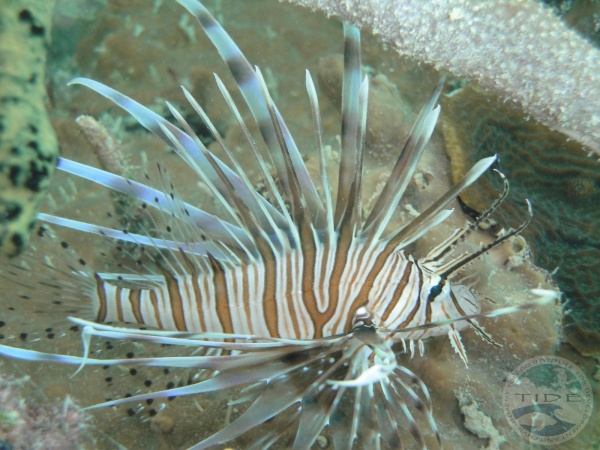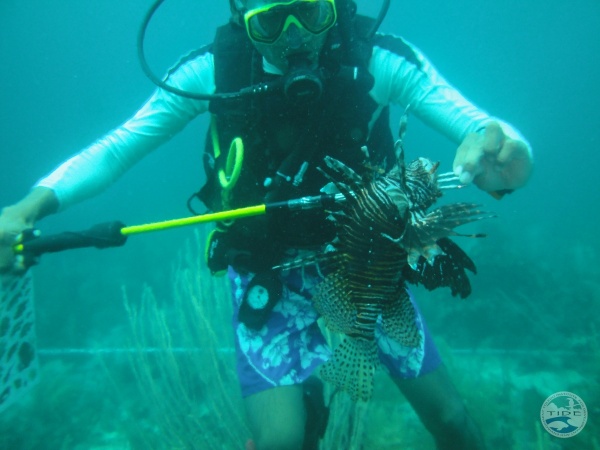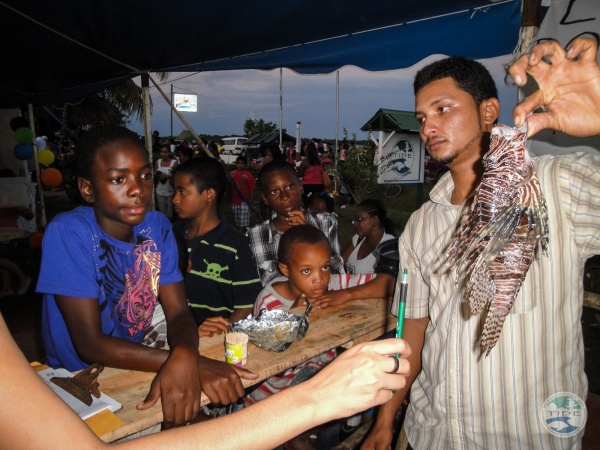Background:
TIDE’s lionfish research aims to monitor the lionfish invasion in PHMR, determining population dynamics and behaviour in the reserve whilst also instigating effective control methods that can be carried out by the local community. Lionfish (Pterois volitans) are an invasive species that have severely affected native fish populations in the Caribbean. Lionfish are native to the Indo-Pacific oceans and the Red Sea, but have swept through Atlantic and Caribbean waters, from Florida to Brazil, during the past 15 years.
As an invasive species, lionfish have no natural predators in the Caribbean and native potential prey species have not evolved a fear response to them. This means they feed freely on juvenile native fish species and crustaceans and rapidly reduce their populations. One estimate shows a single lionfish may decrease the number of juvenile native fish in an area by approximately 79% in just 5 weeks! Therefore, lionfish rapidly affect commercial fish stocks by over-consuming prey species of native fish.

The lionfish invasion is thought to have begun with the release of a few individuals from either domestic or public aquariums during a hurricane in Florida in 1991. Their population has grown rapidly as they outbreed their native competitors by producing up to 2 million eggs each per year. Also significant proportion of the population resides below maximum diver depth limits (some have even been seen at a depth of two hundreds metres!). This makes lionfish a very hard species to control! Lionfish have been observed to live for up to 15 years and females reach maturity at around one year old (at approximately 7-8 inches or 17.8-20.3 cm).
TIDE’s lionfish research:
Lionfish were first discovered in Belize in 2008 and by 2011 they were known to have reached PHMR, making it one of the last protected areas in Belize known to have been affected. In response, TIDE began carrying out a lionfish research project in PHMR using dive surveys and questionnaires to better understand the behaviour and impact of the invasive fish. The project is ongoing and monitors the population density, spatial distribution, preferred habitat type, size frequency distribution, feeding behaviour through gut content analysis, and gender ratio of lionfish in PHMR. The data has helped us to understand more about lionfish, such as which habitat, diet and depth they prefer. It has also allowed us to characterise the progression of the lionfish invasion; by comparing PHMR to areas with more advanced invasions we can estimate how many lionfish may enter the PHMR in the future and we can understand how long they may take for them to stabilise. We can use modelling to predict long -term impacts on native commercial and non-commercial fisheries.

Results so far:
Results have found that the lionfish population in PHMR is so far relatively small and those that are present are found most frequently in groups on rocky outcrops in the outer reef of the reserve. This means they could potentially begin to spread into more central areas of the reserve and negatively effect all of the protected area. Gut content analysis revealed lionfish eat predominantly small fish where available, but are now moving on to shrimp as small fish populations decline (as seen in the graph below). If left unchecked, lionfish could cause the collapse of fish stocks as they are out-competing native commercial species by eating the same prey. This could negatively affect livelihoods of fishermen that depend on them.
Consequently, TIDE and other organisations are working to control the population of lionfish in Belize. In addition to dedicated culling trips, TIDE staff and volunteers spear lionfish whenever they are in the water. Unfortunately, as lionfish are so reproductive and can live at depths of hundreds of metres, far greater than accessible by divers, the conversation is no longer about how we get rid of lionfish, but how we can learn to live with lionfish. Lionfish are here to stay. It is now up to us to control their populations to ensure their impact on native commercial species remains low and under control. Recent studies (Chapman, Foley 2012) have indicated that consistent and regular culling at affected sites is the only way, and this can only be achieved in south Belize by creating the economic incentive for local fishers to target this species.

TIDE is therefore educating people about lionfish to dispel popular misconceptions such as the meat being poisonous (it’s not; only the spines contain venom) and encouraging the local community to view lionfish as a desirable food option in order to generate demand for fishers to catch and sell them. TIDE has been running lionfish taster stalls at public events in Punta Gorda to encourage people to buy, cook and prepare the fish for themselves and order lionfish from restaurants. We also encourage people to buy beautiful lionfish jewellery handmade by local Belizeans. TIDE hopes that by catching and eating lionfish fishers and the community can help TIDE manage their numbers and PHMR can continue to maintain fish stocks in the reserve. This will allow activities such as diving, commercial and recreational fishing and tourism, to continue in and around PHMR.
